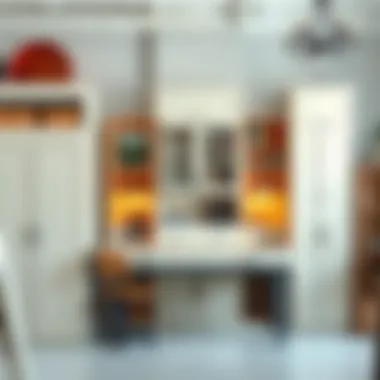Art Studio Storage Cabinets: Organizing Your Creativity


Intro
Creating art is often a deeply personal and messy endeavor, where materials and inspiration can intertwine in chaotic beauty. In an artist's workspace, a cluttered environment can hinder creativity just as much as a lack of supplies can stifle expression. This necessity for organization has led to the growing importance of art studio storage cabinets. These handy structures not only help manage supplies but also play a significant role in shaping the overall atmosphere of a creative space.
As an artist or designer, it’s paramount to establish an environment that fosters efficiency and encourages the flow of creative juices. Investing in the right storage solutions can make all the difference. From cleverly designed cabinets that blend functionality with aesthetics to practical tips on maintaining your setup, this article will guide you through the myriad of options available in the realm of art studio storage.
We'll discuss different furniture design styles that can complement your artist's den. Moreover, we’ll dive into practical tips tailored for homeowners. Whether you're a seasoned professional hoping to refine your workspace or a budding hobbyist just starting out, the right storage cabinets can transform your cluttered corner into a harmonious haven that nurtures creativity.
In an age where art is not just about creation but also about how it’s presented and organized, understanding the integration of storage solutions is crucial. So, grab a cup of coffee, settle in, and let’s explore how you can elevate your creative environment.
Intro to Art Studio Storage
Art studios are not just places to create; they are sanctuaries where inspiration flows and ideas are birthed. However, without efficient storage solutions, the creative process can quickly become chaotic. An organized space is essential to nurturing creativity and enhancing productivity. The importance of art studio storage lies in its ability to provide artists with an environment that fuels their imagination while also ensuring that materials are easily accessible. By utilizing the right storage cabinets, artists can streamline their workflow, allowing them to focus on their craft rather than on managing clutter.
The Importance of Organization in Creative Spaces
To put it simply, a messy space can stifle creativity. When an artist spends precious minutes searching for a paintbrush or digging through piles of supplies, that time is taken away from creating. An organized space means that everything has its place, and everything is in its place. This organization can significantly reduce stress, allowing individuals to immerse themselves into their work without distractions. Furthermore, when supplies are sorted and stored appropriately, it can lead to discovering forgotten materials, sparking fresh ideas and techniques along the way.
"A tidy workspace is not just a reflection of discipline; it’s a canvas of tranquility that enhances the creative process."
Understanding Storage Needs for Different Art Forms
Not all art forms have the same storage requirements. For instance, a painter works with different tools and materials compared to a sculptor or a graphic designer. By understanding the specific needs of various art forms, artists can select the most suitable storage solutions.
- Painters might need ample space for brushes, canvases, and paints, which requires cabinets with adjustable shelving and drawers.
- Sculptors, on the other hand, may require sturdy containment for tools and larger materials. This may lead them to select cabinets designed to hold heavy items safely.
- Graphic designers often work with paper supplies and digital equipment; thus, cabinets may need specialized compartments for organized storage of software, tablets, and sketch pads.
This differentiation in needs drives the design of art studio storage cabinets, making it crucial for artists to evaluate their specific practices. Choosing the right storage solution can dramatically enhance the functionality of the workspace, ultimately fostering creativity.
Key Features of Art Studio Storage Cabinets
When it comes to maximizing creativity and efficiency in an art studio, the choice of storage cabinets plays a significant role. The right storage solutions not only help keep materials organized but also influence how artists interact with their creative space. Proper storage can enhance workflow, spark inspiration, and even reduce wastefulness by ensuring that supplies are easy to access and manage. The features of art studio storage cabinets must be thoughtfully considered, as they contribute directly to the overall functionality and aesthetic of the studio.
Material Considerations
Wood
Wooden storage cabinets are a standout choice because of their warmth and natural beauty. They boast durability, making them suitable for holding a variety of art supplies. One of the defining characteristics of wood is its sturdiness; this means it can withstand the rigors of daily use in a bustling creative environment. An added benefit is that wooden cabinets are often customizable, allowing artists to match them to their studio's decor easily. However, one must consider that wood can be susceptible to damage from moisture and heavy spills, requiring attention to maintenance and care.
Metal
Metal cabinets offer a modern twist with an industrial feel. They are generally more durable than wood, making them ideal for artists who work with heavier supplies and tools. The key characteristic of metal is its resilience; they can endure extensive wear and tear, giving peace of mind to those who need to store heavy items. Metal cabinets may also feature finishes that resist scratches and rust, prolonging their lifespan. On the downside, they might lack the warmth of wood and can feel cold or uninviting in a creative workspace.
Plastic
Plastic storage cabinets are often the go-to option for artists seeking an affordable and lightweight solution. One major advantage of plastic is its resistance to moisture and chemicals, making it a practical choice for those who deal with paints and solvents. Their lightweight nature also enables easy movement, which is great for flexible spaces where rearranging might occur regularly. However, they may not offer the same level of durability as wood or metal, and over time, they can wear down or discolor, especially when exposed to sunlight.


Design and Aesthetic Considerations
Modern vs. Traditional Styles
The choice between modern and traditional styles can significantly impact the overall ambiance of an art studio. Modern styles often embrace minimalism with sleek lines and open spaces, which can foster a sense of clarity and focus—ideal for contemporary artists. Traditional styles, conversely, can bring a sense of history and character, often featuring ornate details that lend warmth and charm. A unique feature of modern design is its adaptability; many contemporary cabinets come with multifunctional purposes, giving artists the freedom to tailor their storage to their workflows. However, the traditional aesthetic may better suit those who appreciate craftsmanship and richer textures.
Color Schemes and Finishes
Color schemes and finishes can greatly enhance the visual appeal of an art studio. Bright, vibrant colors can inspire creativity, while neutral tones may promote calmness and concentration. The key characteristic of a well-chosen color palette is its ability to unify the space, making storage cabinets feel like an integral part of the studio rather than an afterthought. Unique finishing options such as matte, glossy, or textured surfaces can add depth and interest, but artists must find a balance; too many contrasting finishes can create visual chaos.
Functional Features
Adjustable Shelving
Adjustable shelving is a game-changer in the realm of storage. The beauty of these cabinets is their ability to adapt as your needs change. Whether you're stowing oversized canvases today or a collection of paints tomorrow, adjustable shelves provide the flexibility needed in a creative workspace. Notably, the downside is that improper adjustment can lead to instability if not cared for properly, but most models are designed to ease these concerns.
Lockable Doors
Lockable doors are not just a security feature; they represent a layer of protection for your precious supplies. This aspect is particularly important for artists who have valuable materials or tools that need safeguarding, especially in shared spaces. The appeal lies in the peace of mind it provides, allowing an artist to step away from their work without worrying about theft or tampering. On the downside, if frequently accessed, these might become a minor inconvenience, creating friction in fluid workflow.
Mobility Options
Mobility options are essential for artists who prefer adaptability in their workspace. Cabinets with wheels enable easy movement, facilitating the arrangement of creative areas without fatigue. The primary advantage here is that it allows for spontaneous creativity and the freedom to transform the space based on project needs. However, one must be cautious; if wheels aren’t of high quality, they can hinder stability.
"The right storage solutions are like a blank canvas awaiting the artist's touch; they set the tone and mood for creation."
Selecting cabinets with these features can make all the difference in organizing materials, ensuring creativity flows freely without the restrictions of cluttered spaces or misplaced supplies.
Types of Storage Cabinets for Art Studios
When it comes to fostering creativity, the types of storage cabinets in an art studio play a vital role in organizational efficiency. Artists often juggle multiple projects, materials, and tools. Thus, having the right storage solutions can significantly impact the workflow and overall creativity. This section delves deeply into the various types of storage cabinets available, highlighting their specific features and why they are essential in any creative workspace.
Multifunctional Cabinets
Multifunctional cabinets can be regarded as the Swiss Army knife of storage solutions. They offer versatility by combining several storage features in one unit. For example, a single cabinet might include drawers for smaller items, shelves for larger supplies like paper and canvases, and even a section for tools. This flexibility is crucial for artists who may require different storage solutions for various materials.
One of the benefits of multifunctional cabinets is that they maximize space. In smaller art studios, where every inch counts, a single cabinet with various compartments can help declutter significantly. Imagine having all your brushes organized, paints neatly arranged, and tools at hand without scattering them across the room. This organization can lead to improved focus, allowing creativity to flow more freely.
Not only do these cabinets serve practical purposes, but they can also be aesthetically pleasing. They often come in various styles and colors, ensuring they can fit in with the overall design of the studio. A well-chosen cabinet can even inspire creativity on its own, acting as an attractive focal point in the space.
Dedicated Art Supply Cabinets
Dedicated art supply cabinets are designed with artists' specific needs in mind. These cabinets often come customized with compartments tailored for various types of supplies, such as paints, canvases, sketchbooks, and more. Having a dedicated space for art supplies is particularly important for artists who want to keep their materials organized and within easy reach.
The major advantage of these cabinets is that they eliminate confusion, especially for beginners who might have a mountain of supplies. Instead of sifting through piles of items, a dedicated cabinet clearly categorizes everything, making it simple to find what you need. For instance, shelves can be specifically designed for tubes of paint while drawers may cater to brushes and other tools. This deliberate organization is essential in maintaining an efficient workflow.
Additionally, dedicated cabinets can help in preserving artwork and supplies. Many manufacturers use materials that protect against dust and damage, ensuring that everything remains in optimal condition. The right cabinet can also include features like humidity control, which is particularly important in preventing the degradation of sensitive materials.


Display Cabinets
Display cabinets serve a dual purpose: storing and showcasing. For artists, having a display cabinet can be an excellent way to not only keep items organized but also highlight their work. These cabinets typically feature glass doors that provide a clear view of the contents inside, making them ideal for displaying finished artwork or valuable supplies and tools.
The benefit of using display cabinets in an art studio is that they encourage motivation and inspiration. Seeing completed works or important supplies can spark new ideas. Furthermore, a clean and organized display can make the studio feel more professional and inviting, which is especially useful if the space is also used for client meetings or workshops.
Artists can select display cabinets that match their personal style, from sleek and modern to rustic and vintage. This customization makes it easier to create an inviting atmosphere while still fulfilling practical storage needs.
Evaluating Your Space for Storage Solutions
When it comes to crafting an inspiring art studio, the importance of evaluating your space cannot be overstated. It sets the stage for how effectively you can organize your materials and fuels your creative process. By taking the time to thoughtfully assess your space, you address practical considerations that align with your artistic needs, ultimately paving the way for a more effective workspace.
Assessing Available Space
Every art studio is unique, shaped by the dimensions, layout, and even the light that filters in through the windows. Begin by measuring your room—getting down to exact square footage and considering any odd corners or alcoves that might be overlooked at first glance. Take a notebook or use an app to jot down measurements, observing how sunlight moves through the day. Notice any shelves, tables, or furniture you currently have. Are they serving as valuable assets or obstacles in your creative journey?
Also, think about the flow of the space. Does it feel cramped, or is there enough elbow room? You might be surprised to realize that some spaces function better than they appear. For instance, a small nook might be perfect for hanging artwork that you want to see often, or a corner can provide a cozy working spot. Evaluating available space not only indicates what storage solutions might fit, but it also illuminates how you can maneuver around your workspace while staying productive.
Determining Storage Needs
Once you’ve assessed your available space, it’s time to get down to the nitty-gritty—determining what exactly your storage needs are. This requires some introspection about your artistic practice. Consider the types of materials you use: heavy paints, delicate canvases, or perhaps numerous sketchbooks piled high. Assess how often you reach for these supplies. Are they often used or reserved for special pieces?
Think of categorizing these supplies into broad groups, such as:
- Daily essentials: Brushes, paints, palettes, and tools that you use every day.
- Occasionals: Specialty paints, canvases, or tools that you pull out only for specific projects.
- Archived items: Older works, notes, and inspiration pieces that need to be stored safely but aren't accessed frequently.
By clarifying your storage needs this way, you can select cabinets that cater to specific requirements. For example, tall cabinets with ample shelving could house your collection of canvases, while smaller containers could keep your brushes organized and accessible. Remember, it’s not just about storing items neatly; it’s also about creating a system that enhances your creative workflow, making it easier to dive into new projects without fumbling around for supplies.
"The art of storage is not only about keeping things organized, but it’s also about inspiring creativity by making essential items easily reachable."
Innovative Storage Solutions for Limited Spaces
When you’re working with a limited amount of space, clutter can creep in faster than a cat on a hot tin roof. The importance of innovative storage solutions in art studios cannot be overstated. It's not just about shoving things in a corner or cramming supplies into any available nook. Instead, having a system that maximizes every square inch of your workspace can lead to improved efficiency and heightened creativity. Plus, a well-organized environment can ignite inspiration and give clarity to your artistic process.
Artists often face myriad challenges, particularly those in smaller studios or shared spaces. With every inch counted, it becomes crucial to embrace creativity not just in art, but also in how you store your tools and materials. Innovative solutions can help transform your chaos into a well-oiled machine without taking away from your creative essence.
Vertical Storage Ideas
Vertical storage can be a game-changer in compact studios. By using the height of your walls, you can free up floor space while keeping everything you need within arm’s reach. Here are some concepts to consider:
- Wall-Mounted Racks: These can be ideal for storing brushes, paints, and other supplies. A pegboard, for instance, can turn your wall into a creative display, encouraging you to keep your gadgets visible and accessible.
- Shelving Units: Tall shelves go up, and you get more space. By installing sturdy shelves, you can create levels for different supplies, dividing them by medium or functionality. This keeps essentials organized while preserving a sleek aesthetic.
- Hanging Baskets: Think of using hanging wicker or wire baskets. They not only add a decorative touch but also can hold everything from rolls of paper to smaller tools.
Making the most of vertical real estate means less bending and searching, letting you devote energy to your art instead of hunting for materials.
Utilizing Under-Furniture Space


The area under furniture is often overlooked, much like the counters in a bistro at closing time. To leverage this space:
- Art Supply Carts: These can roll under your table and quickly be brought out when needed. It turns your under furniture area into a treasure trove of supplies.
- Storage Bins: Consider clear plastic bins that allow you to see what's inside without digging. These can slide under couches or tables, making it easy to stash away things without sacrificing visibility or accessibility.
- Custom Solutions: If you’re handy, build compartments or drawers to fit snugly beneath your workstations. Tailoring solutions to fit the unique dimensions of your studio can maximize efficiency.
Remember, the goal isn’t just to store art supplies; it’s to create an environment that fosters creativity and productivity.
In the end, innovative solutions for limited spaces aren’t about cramming more items into less space. It’s about thinking outside the box, quite literally, and finding unique ways to integrate functionality and artistry into your surroundings. As you create your masterpieces, the art of storage shouldn’t be an afterthought—it should be a part of your artistic expression.
Tips for Maintaining Organized Art Spaces
Maintaining an organized art space isn’t just about tidiness; it significantly influences the quality of creative work. An efficient setup fosters inspiration and keeps the workflow smooth. An organized studio can help reduce the overwhelm of clutter, allowing artists to focus better on their projects. It also prevents damage to supplies and promotes a professional atmosphere, even if the space is simply your home.
Regular Decluttering Practices
Decluttering is not just about throwing things out; it’s a process that involves evaluating what is essential and what can be let go. Every artist collects supplies, sketches, and tools over time. Some items may have been used once, while others become essential parts of the creative process. Regularly reviewing these items helps keep your workspace functional.
- Set a schedule for decluttering: It can be weekly, monthly, or whatever works for you. The key is consistency. Even a quick ten-minute tidy-up can do wonders.
- Create a 'maybe' pile: When you're not sure about keeping an item, place it in a designated area. After a set period, revisit this pile and assess its value.
- Dispose responsibly: Some items can be recycled or donated. This practice not only clears space but can also benefit others in the creative community.
Labeling and Categorization
Labeling is an art in itself, allowing for quick access and clear organization. When supplies are sorted and marked, locating what you need can happen at the speed of light, reducing frustration during inspiration. This is especially crucial in an art studio, where time spent searching for supplies can feel like time lost.
- Use clear labels: Opt for readable fonts and consistent colors. A simple label maker can make this task easy and professional-looking.
- Categorize by type or project: Organizing supplies by their use not only improves accessibility but also encourages a routine. For example, keep paints together, brushes sorted by size, and canvases in one spot.
- Visual cues: Sometimes, a picture is worth a thousand words. If verbal cues feel too vague, use images to represent the content of bins or containers. This takes labeling to the next level by catering to visual thinkers.
"An organized space reflects a clear mind. When materials are easily accessible, you can flow from inspiration to creation without stumbling over disarray."
Ultimately, incorporating regular decluttering and effective labeling in your art studio can yield a profound impact on not just your workspace but on the overall creative experience as well. These strategies empower artists to nurture their imaginative spirit rather than being held back by a chaotic environment.
The End: The Role of Storage in Fostering Creativity
In the world of creativity, a clutter-free environment isn’t just a luxury, it’s a necessity. Proper storage is paramount for artists, designers, and anyone dabbling in the creative arts. Effective storage solutions can dramatically impact the overall productivity and innovation in any art studio. When your workspace is organized, it streamlines the creative process, allowing for greater focus on the work at hand.
The interplay between physical space and mental clarity can’t be overlooked. With ample storage options, artists can easily access supplies and materials without the headache of sifting through a jumbled mess. For example, a well-placed art supply cabinet may house everything from paints to brushes, keeping everything within arm’s reach during frenetic sessions of inspiration. This accessibility can spur spontaneity, a crucial element in many artistic processes.
Moreover, creatively designed storage cabinets don’t merely serve a functional purpose; they can also enhance the aesthetic appeal of the studio. The visual environment plays a significant role in fostering creativity. Whether it's a sleek modern unit or a rustic wooden cabinet, the right storage solution can serve as a source of inspiration, reflecting the artist’s personal ethos.
It’s not only about what you store but also how you showcase it. > "A flat file for drawings, shelves for books, and pegboards for tools can transform chaotic creativity into structured brilliance."
To ensure the selected storage cabinets align with your creative vision, consider these elements:
- Materials: Different materials like wood, metal, and plastic have different weights, durability, and aesthetic properties that can affect the appearance of your space.
- Functionality: Look for cabinets with features that align with your work style; adjustable shelving for varied supplies or lockable doors for precious items can make all the difference.
- Space Optimization: For smaller studios, consider vertical storage or multifunctional pieces that serve dual purposes, thus saving precious floor space.
In closing, the choice of storage cabinet in any art studio speaks volumes about an artist's approach to organization and creativity. The right choices create a synergistic relationship, fostering an environment where ideas can flow unencumbered by chaos. By integrating suitable storage solutions, artists can reclaim their space for creativity, transforming cluttered chaos into a sanctuary of inspiration.
Final Thoughts on Selecting Storage Cabinets
When it comes to selecting storage cabinets for your art studio, keep functionality and style at the forefront. Take stock of your specific needs: What materials do you work with most? Do you often need to rotate your supplies? It’s vital to choose cabinets that not only hide away the clutter but also invite your creativity to flourish.
Here are some final pointers:
- Assess Your Workflow: Pay attention to how you work and what you need close at hand.
- Think About Your Aesthetic: Choose storage that complements the overall feel of your studio.
- Invest in Quality: While it may be tempting to go for budget options, investing in sturdy, well-designed cabinets pays off in the long run.
- Test Before You Commit: If possible, try out your chosen storage solutions to see how well they accommodate your needs.
Ultimately, the right storage cabinets are more than mere furniture. They are partners in your creative journey, quietly working to support and enhance your craft.















